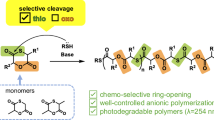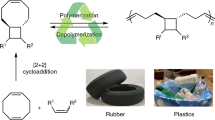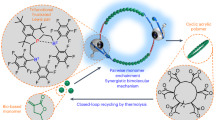Abstract
The ring-opening polymerization behavior of five-membered lactones fused to a cyclohexane ring (that is, the trans- and cis-hexahydro-2(3H)-benzofuranone denoted T6L and C6L, respectively) was investigated under various conditions. The potassium tert-butoxide (tBuOK)-initiated anionic polymerization of T6L yields polymers with number-average molecular weight (Mn) values of 5000. However, no polymeric products were obtained via cationic and coordination polymerization. Among the anionic initiators, a base stronger than an alkoxide initiated the polymerization of T6L. In contrast, cis-isomer C6L did not polymerize regardless of the initiator species used, which implied an increase in the ring strain of the lactone ring by the trans-fused cyclohexane. The anionic polymerization of T6L was reversible, and the thermodynamic parameters characterizing the polymerization of T6L were estimated to be ΔHp°=−18 kJ·mol−1 and ΔSp°=–65 J·K−1mol−1 on the basis of the measurement of the equilibrium monomer concentration.
Similar content being viewed by others
Log in or create a free account to read this content
Gain free access to this article, as well as selected content from this journal and more on nature.com
or
References
Moore, T., Adhikari, R. & Gunatillake, P. Chemosynthesis of bioresorbable poly(γ-butyrolactone) by ring-opening polymerisation: a review. Biomaterials 26, 3771–3782 (2005).
Liu, Q., Jiang, L., Shi, R. & Zhang, L. Synthesis, preparation, in vitro degradation, and application of novel degradable bioelastomers—A review. Prog. Polym. Sci. 37, 715–765 (2012).
Jérôme, C. & Lecomte, P. Recent advances in the synthesis of aliphatic polyesters by ring-opening polymerization. Adv. Drug Deliv. Rev. 60, 1056–1076 (2008).
Yu, Y., Wu, D., Liu, C., Zhao, Z., Yamg, Y. & Li, Q. Lipase/esterase-catalyzed synthesis of aliphatic polyesters via polycondensation: A review. Process Biochem. 47, 1027–1036 (2012).
Carothers, W. H. & Natta, F. J. V. Studies on polymerization and ring formation. III. Glycol esters of carbonic acid. J. Am. Chem. Soc. 52, 314–326 (1930).
Soga, K., Tazuke, Y., Hosoda, S. & Ikeda, S. Polymerization of propylene carbonate. J. Polym. Sci. Polym. Chem. 15, 219–229 (1977).
Vogdanis, L. & Heitz, W. Carbon dioxide as a monomer, 3. The polymerization of ethylene carbonate. Makromol. Chem. Rapid Commun. 7, 543–547 (1986).
Harris, R. F. Structural features of poly(alkylene ether carbonate) diol oligomers by capillary gas chromatography. J. Appl. Polym. Sci. 37, 183–200 (1989).
Vogdanis, L., Martens, B., Uchtmann, H., Hensel, F. & Heitz, W. Synthetic and thermodynamic investigations in the polymerization of ethylene carbonate. Makromol. Chem. 191, 465–472 (1990).
Lee, J.-C. & Litt, M. H. Ring-opening polymerization of ethylene carbonate and depolymerization of poly(ethylene oxide-co-ethylene carbonate). Macromolecules 33, 1618–1627 (2000).
Haba, O., Tomizuka, H. & Endo, T. Anionic ring-opening polymerization of methyl 4,6-O-benzylidene-2,3-O-carbonyl-α-D-glucopyranoside: A first example of anionic ring-opening polymerization of five-membered cyclic carbonate without elimination of CO2 . Macromolecules 38, 3562–3563 (2005).
Haba, O., Furuichi, N. & Akashika, Y. Anionic ring-opening copolymerization of l-lactide with a five-membered cyclic carbonate having a glucopyranoside structure. Polym. J. 41, 702–708 (2009).
Tezuka, K., Komatsu, K. & Haba, O. The anionic ring-opening polymerization of five-membered cyclic carbonates fused to the cyclohexane ring. Polym. J. (2013) (advance online publication, 29 May 2013; doi:10.1038/pj.2013.50).
Newman, M. S. & VanderWerf, C. A. Isomeric lactone pairs related to cyclohexanone-2-acetic acid. J. Am. Chem. Soc. 67, 233–237 (1945).
Hall, H. K. & Schneider, A. K. Polymerization of cyclic esters, urethans, ureas and imides. J. Am. Chem. Soc. 80, 6409–6412 (1958).
Schmidt, M. W., Baldridge, K. K., Boatz, J. A., Elbert, S. T., Gordon, M. S., Jensen, J. H., Koseki, S., Matsunaga, N., Nguyen, K. A., Su, S., Windus, T. L., Dupis, M. & Montgomery, J. A. Jr General atomic and molecular electronic structure system. J. Comput. Chem. 14, 1347–1363 (1993).
Hanwell, M. D., Curtis, D. E., Lonie, D. C., Vandermeersch, T., Zurek, E. & Hutchison, G. R. Avogadro: an advanced semantic chemical editor, visualization, and analysis platform. J. Cheminformatics 4, 17 (2012).
Pirkle, W. H. & Adams, P. E. Enantiomerically pure lactones. 2. Approaches to cis or trans multicyclic lactones. J. Org. Chem. 45, 4111–4117 (1980).
Dainton, F. S. & Ivin, K. J. Some thermodynamic and kinetic aspects of addition polymerisation. Q. Rev. Chem. Soc 12, 61–92 (1958).
Duda, A. & Kowalski, A. in Handbook of Ring-Opening Polymerization eds Dubois P., Coulembier O., Raquez J.-M., (WILEY-VCH Verlag GmbH & Co. kGaA, 2009).
Vofsi, D. & Tobolsky, A. V. Oxonium ion-initiated polymerization of tetrahydrofuran. J. Polym. Sci. Part A 3, 3261–3273 (1965).
Libiszowski, J., Kowalski, A., Szymanski, R., Duda, A., Raquez, J. M., Degée, P. & Dubois, P. Monomer−linear macromolecules−cyclic oligomers equilibria in the polymerization of 1,4-dioxan-2-one. Macromolecules 37, 52–59 (2004).
Eliel, E. L., Wilen, S. H. & Mander, L. N. Stereochemistry of Organic Compounds, (John Wiley & Sons, Inc., 1993).
Schubert, W. K., Southern, J. F. & Schäfer, L. Combined electron diffraction, conformational energy and vibrational investigations of cis-1,4-ditertiary butyl-cyclohexane. J. Mol. Str 16, 403–415 (1973).
Loomes, D. J. & Robinson, M. J. T. Conformational effects in compounds with 6-membered rings—XIII. Tetrahedron 33, 1149–1157 (1977).
Molinski, T. F. & Morinaka, B. I. Integrated approaches to the configurational assignment of marine natural products. Tetrahedron 68, 9307–9343 (2012).
Madison, V., Young, P. E. & Blout, E. R. Cyclic peptides. 14. Conformational energy and circular dichroism of proline-containing cyclic dipeptides. J. Am. Chem. Soc. 98, 5358–5364 (1976).
Hermans, R. J. M. & Buck, H. M. A phosphorus-31 and proton NMR study of the conformations of a series of diastereomeric 3-substituted trans-2,4-dioxa-3-oxo- and trans-2,4-dioxa-3-thioxo-3-phosphabicyclo[4.3.0]nonanes as model compounds for cyclic nucleotides. J. Org. Chem. 52, 5150–5157 (1987).
Li, Z. & Mukamel, S. First-principles simulation of amide and aromatic side chain ultraviolet spectroscopy of a cyclic dipeptide. J. Phys. Chem. A 111, 11579–11583 (2007).
Quintero, L., Sánchez-Vazquez, M., Cruz-Gregorio, S. & Sartillo-Piscil, F. On the existence of the chair conformation in six-membered ring phosphates bearing an aryl group axially oriented at the c4 position: cyclic nucleotides as model compounds for cyclic phosph(on)ate and phosphoramide prodrugs. J. Org. Chem. 75, 5852–5859 (2010).
Mastryukov, V. S., Popik, M. V., Dorofeeva, O. V., Golubinskii, A. V., Vilkov, L. V., Beikova, N. A. & Allinger, N. L. Chair-boat equilibriums in bicyclo[3.3.1]nonane at 65 and 400.degree.C studied by electron diffraction and molecular mechanics. J. Am. Chem. Soc. 103, 1333–1337 (1981).
Kirchen, R. P. & Sorensen, T. S. Conformational analysis of tertiary cycloalkyl (C6, C7, C8) carbocations. Unexpected preference for the twist-boat conformation in the cyclohexyl case. J. Am. Chem. Soc. 100, 1487–1494 (1978).
Squillacote, M., Sheridan, R. S., Chapman, O. L. & Anet, F. A. L. Spectroscopic detection of the twist-boat conformation of cyclohexane. Direct measurement of the free energy difference between the chair and the twist-boat. J. Am. Chem. Soc. 97, 3244–3246 (1975).
Acknowledgements
We thank Professor Seigou Kawaguchi from Yamagata University for his helpful advice regarding the density measurements.
Author information
Authors and Affiliations
Corresponding author
Rights and permissions
About this article
Cite this article
Haba, O., Itabashi, H. Ring-opening polymerization of a five-membered lactone trans-fused to a cyclohexane ring. Polym J 46, 89–93 (2014). https://doi.org/10.1038/pj.2013.70
Received:
Revised:
Accepted:
Published:
Issue date:
DOI: https://doi.org/10.1038/pj.2013.70
Keywords
This article is cited by
-
Insights into substitution strategy towards thermodynamic and property regulation of chemically recyclable polymers
Nature Communications (2023)
-
Chemically recyclable copolyesters from bio-renewable monomers: controlled synthesis and composition-dependent applicable properties
Science China Chemistry (2023)
-
Chemical recycling to monomer for an ideal, circular polymer economy
Nature Reviews Materials (2020)
-
Anionic ring-opening polymerization of five-membered cyclic carbonates derived from aldohexopyranosides
Polymer Bulletin (2015)



